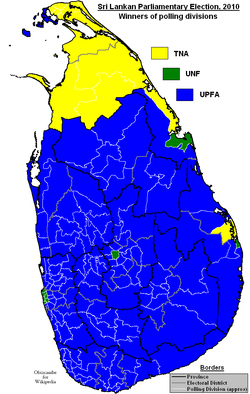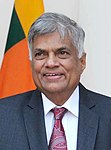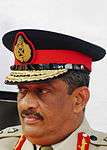| |||||||||||||||||||||||||||||||||||||||||||||||||||||||||||||||||||||||||||||
All 225 seats to the Parliament of Sri Lanka 113 seats were needed for a majority | |||||||||||||||||||||||||||||||||||||||||||||||||||||||||||||||||||||||||||||
|---|---|---|---|---|---|---|---|---|---|---|---|---|---|---|---|---|---|---|---|---|---|---|---|---|---|---|---|---|---|---|---|---|---|---|---|---|---|---|---|---|---|---|---|---|---|---|---|---|---|---|---|---|---|---|---|---|---|---|---|---|---|---|---|---|---|---|---|---|---|---|---|---|---|---|---|---|---|
| Turnout | 61.26% | ||||||||||||||||||||||||||||||||||||||||||||||||||||||||||||||||||||||||||||
| |||||||||||||||||||||||||||||||||||||||||||||||||||||||||||||||||||||||||||||
 Winners of polling divisions. UPFA in blue, UNF in green and TNA in yellow. | |||||||||||||||||||||||||||||||||||||||||||||||||||||||||||||||||||||||||||||
| |||||||||||||||||||||||||||||||||||||||||||||||||||||||||||||||||||||||||||||
| This article is part of a series on the |
| Politics of Sri Lanka |
|---|
 |
Parliamentary elections were held in Sri Lanka on 8 and 20 April 2010, to elect 225 members to Sri Lanka's 14th Parliament.[1] 14,088,500 Sri Lankans were eligible to vote in the election at 11,102 polling stations. It was the first general election to be held in Sri Lanka following the conclusion of the civil war which lasted 26 years.
The main parties contesting in the election were the ruling United People's Freedom Alliance (UPFA), the main opposition United National Front (UNF) and the Democratic National Alliance (DNA) led by former commander of the Sri Lankan Army Sarath Fonseka. President Mahinda Rajapaksa had previously been reelected as president in January 2010.
As expected, the UPFA secured a landslide victory in the elections, buoyed by its achievement of ending the 30 year Sri Lankan Civil War and defeating the Liberation Tigers of Tamil Eelam in May 2009. The UPFA won a large majority in the parliament, obtaining 144 seats, an increase of 39 since the 2004 election. The main opposition UNF won 60 seats, a decline of 22. The minority Tamil party Tamil National Alliance (TNA) won 14 seats, down from the 22 they won in 2004, and the DNA, contesting for the first time, won 7 seats.[2][3] The UPFA however fell short of its goal of obtaining a two-thirds supermajority in the house, which it would have needed to change the constitution on its own.[4] The election had the lowest voter turnout in Sri Lanka since independence.[5]
While the elections were initially scheduled to be concluded on 8 April, irregularities in two districts led the Commissioner of Elections to hold re-polls on 20 April. Final results were announced the following day, a day before the new parliament was scheduled to meet for the first time.
- ^ "6th Parliament Dissolved". News and Events. Parliament of Sri Lanka. 10 February 2010. Archived from the original on 4 March 2010. Retrieved 13 February 2010.
- ^ Sirilal, Ranga. "Sri Lanka ruling party records landslide win at polls". Montrealgazette.com. Archived from the original on 2010-04-24. Retrieved 2010-04-21.
- ^ "Department of Election". Slelections.gov.lk. Archived from the original on 2010-04-21. Retrieved 2010-04-21.
- ^ "Sri Lanka ruling party wins majority in parliament", BBC News, 9 April 2010
- ^ Haviland, Charles (21 April 2010). "Final Sri Lanka vote count confirms Rajapaksa triumph". BBC News. Retrieved 21 April 2010.



